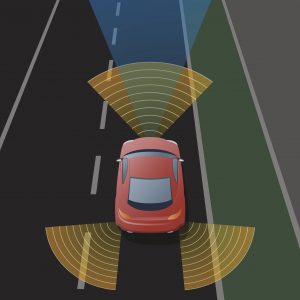As vehicles continue to get smarter, some new alignments and calibrations are required to keep your vehicle operating safely. The Advanced Driver-Assistance System (ADAS) is a common feature in most modern vehicles.
Using multiple sensors, ADAS introduces a variety of safety features such as lane assist, adaptive lighting, autonomous emergency braking, and lane departure warnings. The ADAS calibration process ensures the correct alignment of the camera and sensors used by these systems to keep your vehicle operating safely.
Proper care for your ADAS is critical to your safety, which is why Three Rivers Auto Glass is proud to offer the latest car re-calibration services.
Why Should I Have My ADAS Calibrated?
 Many of the ADAS features rely on cameras or sensors working together to feed in the information. These cameras or sensors are located in the car windshield, front bumper, or front grille in many cases. You may require calibration in the event of:
Many of the ADAS features rely on cameras or sensors working together to feed in the information. These cameras or sensors are located in the car windshield, front bumper, or front grille in many cases. You may require calibration in the event of:
- Windshield replacement
- A front-end collision
- Repair or replacement of the front bumper
For example, one major component of the ADAS is the multi-function camera mounted in the center, behind the top of the windshield. This camera must be situated properly in relationship with the other sensors and cameras in your car. So, when you have your windshield replaced, you will need to have your car re-calibrated to correct any tracking or misalignment issues.
If your ADAS is not calibrated correctly, the car’s system could fail to alert you or may alert you at the wrong time. This can lead to you making a quick decision at the wrong time due to false information.
This why at Three Rivers Auto Glass, we invest in having the proper skills and knowledge to perform car re-calibrations. Your safety is our top priority which is why we offer the latest in ADAS equipment.
Professional ADAS Calibration Services in Pittsburgh
At Three Rivers Auto Glass, we have been in the glass business for over 40 years, providing our Pittsburgh clients with top-quality windshield repairs and replacements. With a highly trained team and the latest ADAS equipment, we can re-calibrate your car to keep you safe out on the road! Contact us today to learn more.
Frequently Asked Questions
ADAS
Many newer vehicles have front-facing cameras mounted to the windshield to help assist the driver in avoiding collisions and injury. After a windshield replacement, many vehicle manufacturers require these camera systems to be recalibrated. This helps to ensure that the safety systems work correctly and provide the driver with accurate information.


